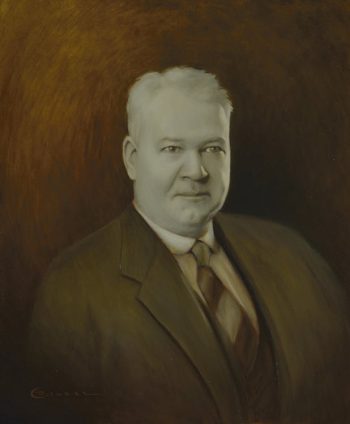Ward Edgar Jones
- Canadian Agricultural Hall of Fame
- Inductees
- Ward Edgar Jones

- Inducted: 2015
- Residing Province: Alberta
- Gallery Location: 200
Ward Edgar Jones
- (1889
- -
- 1937)
Best known as a founding father of the 4-H movement in Canada, the late E. Ward Jones made tremendous strides and contributions to Canadian agriculture as a farmer, an innovator and a teacher during his short 48 year life.
Ward was born in 1889 in Carmen, Manitoba. He graduated from the Manitoba Agricultural College in 1911 and began his career as a professor at the college for the next five years. It was during this time, in 1913, that he co-founded one of the most influential agricultural clubs in Canada – the Boys and Girls Club. What began in Roland, a small farming community southwest of Winnipeg, became the popular 4-H clubs across Canada we all know today.
As a leader and visionary, Ward took a different approach to education, especially when it came to agriculture. Seeing the limitations of classroom learning, and the opportunities with what were progressive approaches to learning at the time, he used field trips, competitive events and distance education to help deliver practical agricultural education and training.
Far ahead of his time, Ward looked for innovative ways to bring new technologies to farming, and farm and home management practices. Under his vision, a railway car was transformed into a travelling classroom to bring new ideas to 4-H club members around the region.
His drive to continuously improve took him to the Alberta Stockyards Company in Calgary. Under his management from 1919 to 1928, Ward focused on using scientific breeding strategies to raise the standards of animal husbandry and crop production to ultimately improve marketing opportunities for prairie farmers.
From 1928 until the time of his death, Ward was the superintendent of agriculture and animal industry for the CPR Department of Natural Resources, with responsibilities for the CPR supply farm in Alberta and three experimental farms. His innovative approach saw him develop and implement systems to improve yield and quality of crop and animal products. Interestingly, these are production improvements on which the Canadian agricultural system continues to focus tremendous research and education investments, more than 85 years later.
Ward Jones shared his ideas through his involvement in many provincial and national agricultural organizations, crossing all segments of the industry. He was president of the Alberta Cattle Breeders’ Association, the Holstein-Friesian Association of Canada and the Alberta Swine Breeders’ Association.
Mieux connu comme l’un des fondateurs du mouvement 4-H au Canada, le regretté Edgar Ward Jones a fait d’importantes contributions à l’agriculture canadienne en tant qu’agriculteur, innovateur et professeur pendant ses courtes 48 années d’existence.
Ward est né en 1889 à Carmen, au Manitoba. Diplômé du Manitoba Agricultural College en 1911, il y a enseigné pendant les cinq prochaines années. C’est pendant cette période, soit en 1913, qu’il a cofondé l’un des clubs agricoles les plus influents au Canada : le Club des garçons et filles. Ce qui a commencé à Roland, petite communauté agricole au sud-ouest de Winnipeg, est devenu les clubs 4-H que nous connaissons tous d’un bout à l’autre du Canada.
Par son leadership et son esprit visionnaire, Ward a abordé l’éducation de manière différente, en particulier lorsqu’il s’agissait d’agriculture. Voyant les limites de l’enseignement en classe et les possibilités qu’offraient les approches progressistes en matière d’apprentissage à l’époque, il s’est tourné vers l’organisation d’excursions sur le terrain, la tenue de concours et la mise sur pied de programmes d’enseignement à distance pour aider à dispenser une formation pratique dans le domaine agricole.
Bien en avance sur son temps, Ward a toujours cherché des moyens novateurs d’intégrer les nouvelles technologies à l’agriculture et aux pratiques de gestion agricole et domestique. Conformément à sa vision, un wagon de train a été transformé en salle de classe itinérante afin d’apporter de nouvelles idées aux membres des clubs 4-H de la région.
Son désir d’amélioration continue l’a conduit à l’Alberta Stockyards Company, à Calgary. Sous sa direction de 1919 à 1928, l’accent y a été mis sur l’utilisation de stratégies de sélection scientifiques pour rehausser les normes d’élevage et de production végétale et ultimement améliorer les possibilités commerciales pour les agriculteurs des Prairies.
De 1928 jusqu’à son décès, Ward a été surintendant de l’industrie agricole et animale pour le Service des ressources naturelles du Chemin de fer Canadien Pacifique, qui était responsable de la ferme d’approvisionnement de CP en Alberta et de trois fermes expérimentales. Son approche novatrice l’a amené à élaborer et implanter des systèmes destinés à améliorer le rendement et la qualité des produits végétaux et animaux. Fait intéressant, il s’agit là d’améliorations à la production vers lesquelles le système agricole canadien continue de diriger d’énormes investissements en recherche et éducation, plus de 85 ans plus tard.
Ward Jones a partagé ses idées grâce à son engagement dans de nombreuses organisations agricoles provinciales et nationales, à travers tous les segments de l’industrie. Il a été président de l’Alberta Cattle Breeders’ Association, de l’Association Holstein-Friesian du Canada et de l’Alberta Swine Breeders’ Association.
- Canadian 4-H Council


